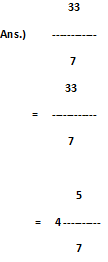CLASS-4
CONVERSION FROM FRACTION TO COMPLEX FRACTION
CONVERSION FROM FRACTION TO COMPLEX FRACTION
33
Example1.) -------- = ?
7

Step.1) Here you can observe that, ‘Numerator’ is greater than ‘Denominator’. In the first stage, we will divide ‘Numerator’ (count as ‘Dividend’) by ‘Denominator’ ( count as ‘Divisor’) of the given fraction.
Step.2) In this stage, place ‘Divisor’, ‘Quotient’ and ‘Remainder’ obtained from division.
like below formation-
7 ) 3 3 ( 4
2 8
----------
5 Remainder (Numerator)
Quotient (Whole Number) --------------------------
Divisor (Denominator)
5
= 4 -------- (Ans.)
7
47
Example 2.) -------- = ?
5
47
Ans.) ---------
5
2
= 9 --------
5
Step.1) Here you can observe that, ‘Numerator’ is greater than ‘Denominator’. In the first stage, we will divide ‘Numerator’ (count as ‘Dividend’) by ‘Denominator’ (count as ‘Divisor’) of the given fraction.
5 ) 4 7 ( 9
4 5
------------
2
Step.2) In this stage, place ‘Divisor’, ‘Quotient’ and ‘Remainder’ obtained from division
like below formation-
Remainder (Numerator)
Quotient (Whole Number) --------------------------
Divisor (Denominator)
2
= 9 --------- (Ans.)
5
51
Example3.) -------- = ?
8
51
Ans.) ---------
8
51
= ------------
8
3
= 6 ------
8
Step.1) Here you can observe that, ‘Numerator’ is greater than ‘Denominator’ In the first stage, we will divide ‘Numerator’ (count as ‘Dividend’) by ‘Denominator’ ( count as ‘Divisor’) of the given fraction.
8 ) 5 1 ( 6
4 8
---------
3
Step.2) In this stage, place ‘Divisor’, ‘Quotient’ and ‘Remainder’ obtained from division
like below formation-
Remainder (Numerator)
Quotient (Whole Number) --------------------------
Divisor (Denominator)
3
= 6 -------- (Ans.)
8